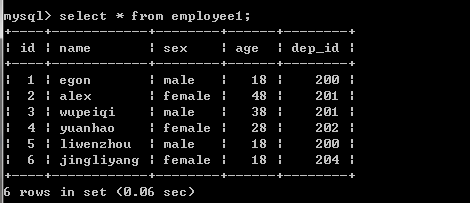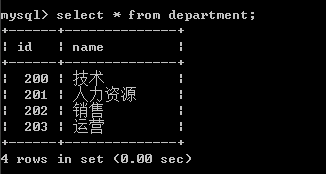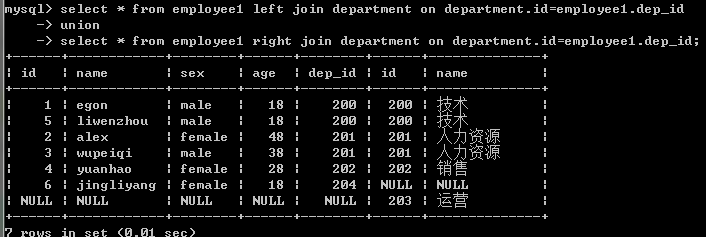一、介绍
首先先准备表
员工表和部门表
#建表
create table department(
id int,
name varchar(20)
);
create table employee1(
id int primary key auto_increment,
name varchar(20),
sex enum('male','female') not null default 'male',
age int,
dep_id int
);
#插入数据
insert into department values
(200,'技术'),
(201,'人力资源'),
(202,'销售'),
(203,'运营');
insert into employee1(name,sex,age,dep_id) values
('egon','male',18,200),
('alex','female',48,201),
('wupeiqi','male',38,201),
('yuanhao','female',28,202),
('liwenzhou','male',18,200),
('jingliyang','female',18,204)
;
查看表:


二、多表连接查询
1.交叉连接:不适用任何匹配条件。生成笛卡尔积、
select * from employee1 ,department;
2.内连接:找两张表共有的部分,相当于利用条件从笛卡尔积结果中筛选出了正确的结果。(只连接匹配的行)
#找两张表共有的部分,相当于利用条件从笛卡尔积结果中筛选出了正确的结果 #department没有204这个部门,因而employee表中关于204这条员工信息没有匹配出来 select * from employee1,department where employee1.dep_id=department.id; #上面用where表示的可以用下面的内连接表示,建议使用下面的那种方法 select * from employee1 inner join department on employee1.dep_id=department.id;
#也可以这样表示哈
select employee1.id,employee1.name,employee1.age,employee1.sex,department.name from
employee1,department where employee1.dep_id=department.id;

注意:内连接的join可以忽略不写,但是还是加上看起来清楚点

3.左连接:优先显示左表全部记录。
#左链接:在按照on的条件取到两张表共同部分的基础上,保留左表的记录 select * from employee1 left join department on department.id=employee1.dep_id;
select * from department left join employee1 on department.id=employee1.dep_id;


4.右链接:优先显示右表全部记录。
#右链接:在按照on的条件取到两张表共同部分的基础上,保留右表的记录 select * from employee1 right join department on department.id=employee1.dep_id;
select * from department right join employee1 on department.id=employee1.dep_id;


5.全外连接:显示左右两个表的全部记录。
注意:mysql不支持全外连接 full join 强调:mysql可以使用union间接实现全外连接
select * from employee1 left join department on department.id=employee1.dep_id union select * from employee1 right join department on department.id=employee1.dep_id;

三、符合条件连接查询
示例1:以内连接的方式查询employee和department表,并且employee表中的age字段值必须大于25,
即找出公司所有部门中年龄大于25岁的员工
select * from employee1 inner join department on employee1.dep_id=department.id
and age>25;
示例2:以内连接的方式查询employee和department表,并且以age字段的升序方式显示
select * from employee1 inner join department on employee1.dep_id=department.id
=
and age>25 and age>25 order by age asc;
四、子查询
#1:子查询是将一个查询语句嵌套在另一个查询语句中。 #2:内层查询语句的查询结果,可以为外层查询语句提供查询条件。 #3:子查询中可以包含:IN、NOT IN、ANY、ALL、EXISTS 和 NOT EXISTS等关键字 #4:还可以包含比较运算符:= 、 !=、> 、<等
小练习
#查询平均年龄在25岁以上的部门名 select name from department where id in ( select dep_id from employee group by dep_id having avg(age) > 25 ); #查看技术部员工姓名 select name from employee where dep_id = (select id from department where name='技术'); #查看小于2人的部门名 select name from department where id in ( select dep_id from employee1 group by dep_id having count(id) < 2 ) union select name from department where id not in (select distinct dep_id from employee1); #提取空部门 #有人的部门 select * from department where id not in (select distinct dep_id from employee1); 或者: select name from department where id in ( select dep_id from employee1 group by dep_id having count(id) < 2 union select id from department where id not in (select distinct dep_id from employee1); );
五、综合练习
一、SELECT语句关键字的定义顺序

SELECT DISTINCT <select_list> FROM <left_table> <join_type> JOIN <right_table> ON <join_condition> WHERE <where_condition> GROUP BY <group_by_list> HAVING <having_condition> ORDER BY <order_by_condition> LIMIT <limit_number>
二 、SELECT语句关键字的执行顺序
(7) SELECT (8) DISTINCT <select_list> (1) FROM <left_table> (3) <join_type> JOIN <right_table> (2) ON <join_condition> (4) WHERE <where_condition> (5) GROUP BY <group_by_list> (6) HAVING <having_condition> (9) ORDER BY <order_by_condition> (10) LIMIT <limit_number>
init.sql文件内容
从init.sql文件中导入数据
#准备表、记录 mysql> create database db1; mysql> use db1; mysql> source /root/init.sql

1、查询所有的课程的名称以及对应的任课老师姓名 2、查询学生表中男女生各有多少人 3、查询物理成绩等于100的学生的姓名 4、查询平均成绩大于八十分的同学的姓名和平均成绩 5、查询所有学生的学号,姓名,选课数,总成绩 6、 查询姓李老师的个数 7、 查询没有报李平老师课的学生姓名 8、 查询物理课程比生物课程高的学生的学号 9、 查询没有同时选修物理课程和体育课程的学生姓名 10、查询挂科超过两门(包括两门)的学生姓名和班级 、查询选修了所有课程的学生姓名 12、查询李平老师教的课程的所有成绩记录 13、查询全部学生都选修了的课程号和课程名 14、查询每门课程被选修的次数 15、查询之选修了一门课程的学生姓名和学号 16、查询所有学生考出的成绩并按从高到低排序(成绩去重) 17、查询平均成绩大于85的学生姓名和平均成绩 18、查询生物成绩不及格的学生姓名和对应生物分数 19、查询在所有选修了李平老师课程的学生中,这些课程(李平老师的课程,不是所有课程)平均成绩最高的学生姓名 20、查询每门课程成绩最好的前两名学生姓名 21、查询不同课程但成绩相同的学号,课程号,成绩 22、查询没学过“叶平”老师课程的学生姓名以及选修的课程名称; 23、查询所有选修了学号为1的同学选修过的一门或者多门课程的同学学号和姓名; 24、任课最多的老师中学生单科成绩最高的学生姓名
答案待续。。。。

1、查询所有的课程的名称以及对应的任课老师姓名 select cname 课程名称,tname 老师姓名 from course left join teacher on course.teacher_id = teacher.tid; 2、查询学生表中男女生各有多少人 select gender ,count(gender) from student group by gender; 3、查询物理成绩等于100的学生的姓名 select sname from student inner join score on student.sid = score.student_id join course on score.course_id = course.cid where cname = '物理' and num = 100; 4、查询平均成绩大于八十分的同学的姓名和平均成绩 (1): select sname 姓名,avg(num) 平均成绩 from student inner join score on student.sid = score.student_id group by student_id having avg(num)>80; (2): select sname,avg(num) from student inner join score on student.sid = score.student_id group by student_id having avg(num)>80 5、查询所有学生的学号,姓名,选课数,总成绩 select student.sid 学号,sname 姓名,count(course_id) 选课数,sum(num) 总成绩 from student left join score on student.sid = score.student_id group by student.sid ; 6、 查询姓李老师的个数 select count(tid) from teacher where tname like '李%'; 7、 查询没有报李平老师课的学生姓名 select sname 姓名 from student where sid not in ( select student_id from score where course_id in( select cid from course where teacher_id =( select tid from teacher where tname = '李平老师' ))); 8、 查询物理课程比生物课程高的学生的学号 select t1.student_id 学号 from (select student_id ,num from score inner join course on score.course_id=course.cid where cname='物理' )as t1 inner join (select student_id , num from score inner join course on score.course_id=course.cid where cname = '生物') as t2 on t1.student_id = t2.student_id where t1.num>t2.num; 9、 查询没有同时选修物理课程和体育课程的学生姓名 (1): select sname from student inner join score on student.sid = score.student_id join course on course.cid=score.course_id and cname in ('物理','体育') group by student_id having count(course_id)!=2; (2): select sname from student join score on student.sid = score.student_id join course on course.cid=score.course_id where cname ='物理' or cname= '体育' group by student_id having count(course_id) !=2; 10、查询挂科超过两门(包括两门)的学生姓名和班级 select sname 姓名,caption 班级 from student inner join score on student.sid = score.course_id join class on class.cid = score.course_id where num<60 group by student_id having count(course_id)>=2; 11、查询选修了所有课程的学生姓名 (1) select sname 姓名 ,所有的课程数 from student inner join (select student_id,count(course_id) 所有的课程数 from score group by student_id having count(course_id) = ( select count(cid) from course)) as t1 on t1.student_id = student.sid; (2) select sname,count(course_id) from student inner join score on student.sid = score.student_id group by student_id having count(course_id)=(select count(cid) from course); 12、查询李平老师教的课程的所有成绩记录 (1): select num from score inner join course on course.cid=score.course_id join teacher on teacher.tid=course.teacher_id where tname = '李平老师'; (2): select num from score where course_id in(select cid from course where teacher_id= (select tid from teacher where tname='李平老师')); 13、查询全部学生都选修了的课程号和课程名 select cid 课程号,cname 课程名 from course select ; 14、查询每门课程被选修的次数 (1) select course.cname,count(student_id) 选课人数 from score inner join course on score.course_id=course.cid group by course_id; (2):也可以按照name分组 select course.cname,count(student_id) 选课人数 from score inner join course on score.course_id=course.cid group by cname; 15、查询之选修了一门课程的学生姓名和学号 select sname 姓名,student_id 学号 from student inner join score on student.sid = score.student_id group by student_id having count(course_id)=1; 16、查询所有学生考出的成绩并按从高到低排序(成绩去重) select distinct num from score order by num desc; 17、查询平均成绩大于85的学生姓名和平均成绩 (1): select sname 姓名,avg(num) 平均成绩 from student inner join score on student.sid = score.student_id group by student_id having avg(num)>85; (2): select student.sname,avg_num from student inner join (select student_id,avg(num) as avg_num from score group by student_id having avg(num) > 85 ) t1 on student.sid=t1.student_id; 18、查询生物成绩不及格的学生姓名和对应生物分数 (1): select student.sname ,num 生物成绩 from student inner join score on student.sid = score.student_id join course on course.cid=score.course_id where cname='生物' and num<60; (2): select student.sname,t1.num from student inner join ( select student_id,num from score where course_id=(select cid from course where cname='生物') and num < 60 ) t1 on t1.student_id=student.sid ; 19、查询在所有选修了李平老师课程的学生中,这些课程(李平老师的课程,不是所有课程)平均成绩最高的学生姓名 select sname from student where sid=( select student_id from score where course_id in ( select cid from course where teacher_id=(select tid from teacher where tname='李平老师') ) group by student_id order by avg(num) desc limit 1 )
